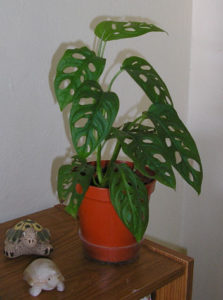
Common houseplants like Philodendrons can have a high plant toxicity rating.
Plants Are Devious
We don’t often think about plant toxicity when choosing plants for our home or landscape. However, the plant world includes some very creative defense mechanisms against pests and browsers.
These defenses range from physical barriers like thorns to deadly poisons. To complicate matters, one part of a plant may be edible while another is highly toxic. You must also consider the physiology differences between humans and our animal companions. Chocolate, for example, is a great treat for a human but a highly toxic substance for a dog.
There are some great resources to help you navigate whether or not a plant should be included in your home or landscape. We’ve included a chart to get you started that has been compiled from information provided by J.S. Lee, DVM,DACVECC,DABT via the Veterinary Information Network.com (https://www.vin.com/vin/)
For a list of plant toxicity ratings, please visit the American Society for the Prevention of Cruelty to Animals® (ASPCA®) Toxic and Non Toxic Plant List.
Lilies Especially Toxic for Cats |
||
Common Name |
Botanical Name |
Note |
|---|---|---|
| Easter Lily | Lilium longiflorum | All parts of these plants, even the pollen and the water that cut flowers rest in, can be fatal for cats. Signs will start with vomiting and depression and can progress to kidney failure within 3 days. Immediate hospitalization is necessary, Call your veterinarian immediately. |
| Tiger Lily | Lilium lancifolium | |
| Japanese Show Lily | Lilium speciosum | |
| Stargazer Lily | Lilium orientalis ‘Stargazer‘ | |
| Rubrum Lily | Lilium speciosum var. rubrum | |
| Day Lily | Genus Hemerocallis | |
Please visit the ASPCA® Toxic and Non-Toxic Plant List – Cats for more plant toxicity ratings.
Please visit the ASPCA® Toxic and Non-Toxic Plant List – Dogs for more plants and their toxicity rating.
Toxic Flower Bulbs |
||
Common Name |
Botanical Name |
Note |
|---|---|---|
| Daffodils | Narcissus genus | The toxic agent of the above plants is found in the bulbs, not the flowers or foliage. Small amounts cause gastrointestinal upset, but large amounts of daffodil bulbs can affect the heart and nervous system. With small amounts of tulip and hyacinth ingestion, vomiting and diarrhea are typical but large amounts of these plants can result in heart, breathing and skin problems. |
| Tulips | Tulipa genus | |
| Hyacinths | Hyacinthus genus | |
Additional Resources for Pet and Livestock Owners
American Society for the Prevention of Cruelty to Animals® (ASPCA®) Poison Control Center https://www.aspca.org/pet-care/animal-poison-control
Poisonous plants list – ASPCA: https://www.aspca.org/pet-care/animal-poison-control/toxic-and-non-toxic-plants
ASPCA Toxic and Non-Toxic Plant List – Dogs: https://www.aspca.org/pet-care/animal-poison-control/dogs-plant-list
ASPCA Toxic and Non-Toxic Plant List – Cats https://www.aspca.org/pet-care/animal-poison-control/cats-plant-list
Earth-Kind Landscaping Common Poisonous Plants and Plant Parts https://aggie-horticulture.tamu.edu/earthkind/landscape/poisonous-plants-resources/common-poisonous-plants-and-plant-parts/
University of Vermont Extension Poisonous Plants https://www.uvm.edu/riskmanagement/poisonous-plants



